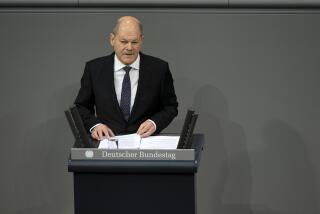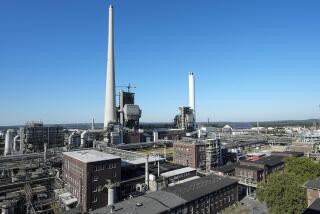Progress Brings a SigAlert as East Germans Catch Up : Unification: A year and $66 billion later, modernization is making headway--but slowly.
- Share via
BERLIN — Eberhard Diepgen was enjoying a drive across the countryside recently when he ran smack into the 20th Century. Or, rather, eastern Germany did.
Construction work had caused what every motorist has come to expect in the former Communist region: a massive, motionless, turn-off-the-ignition-and-just- sit-for-two-hours traffic jam.
“I was really annoyed,” admitted Diepgen, the mayor of Berlin. But then he learned that the reason he wasn’t moving forward was because eastern Germany is.
“Bridges that hadn’t been maintained for 40 or 50 years were being repaired up ahead,” Diepgen explained.
With the first anniversary of German unification coming this Thursday, such scenes are not uncommon as efforts to rebuild the dilapidated east slowly but surely make headway. For even while the people of east and west remain emotionally apart, the physical evidence of two Germanys is beginning to disappear.
“Before, everything used to reek of an undefinable mixture of lignite, exhaust fumes and disinfectant,” commented the respected weekly newspaper Die Zeit. “Now the whole land smells of fresh paint.”
In Bonn, government spokesman Dieter Vogel acknowledges that big challenges still lie ahead, but he adds, “We’ve pretty much accomplished what we expected to in a year.”
And the cost, so far, has been a staggering 100 billion marks ($66 billion).
Still, a sense of impatience is almost palpable in the east, where anxiety over rising unemployment has replaced the euphoria of November, 1989, when the Berlin Wall fell.
“If you look at what was East Germany, you see all this support from the affluent west, which is something the rest of the East Bloc can only dream about,” said Vogel. “But people don’t compare eastern Germany to Poland. They compare it to western Germany, and they see that it’s better here, and of course they want that as fast as possible, which is only right.”
However, as Mayor Diepgen found out, the path of progress is not without its roadblocks.
For example, telephone connections between east and west have improved tremendously this year--but millions of eastern families still have no phone. “They’ll probably have to wait up to two years,” said Klaus Czerwinski of Telekom, the national phone company.
To encourage investment in the east, he said, priority is being given to commercial enterprises, as well as to emergency services and government offices.
In Communist East Germany, people waited 12 to 30 years for a phone that, inevitably, was poor quality, rigged to a party line--and bugged by the secret police.
“We’ve put in 500,000 new phone lines,” Czerwinski said. “That’s more in one year than in the entire 40-year history of East Germany.” Public phones have been hooked up in the 2,000-plus villages that had no telephones whatsoever, he added.
Construction in the east is also booming, figures show, but that, too, has its downside.
Cities such as Dresden are proudly restoring medieval castles and cathedrals--but not the substandard yet desperately needed apartments in the east.
“More than half a million apartments are uninhabitable,” said Joachim Schnurr of the Building Ministry. “So far, we’ve gotten 50,000 ready or almost ready.
“You go to Leipzig and you’ll see rows and rows of apartment houses where the top floors are empty because the rain pours in and no one can live there,” he said.
But work cannot be done until questions about property ownership are cleared up. More than 1 million claims have been filed by people who say the Communists--or, earlier, the Nazis--seized their homes or businesses.
Understaffed, backlogged eastern courts have not made noticeable progress in sorting out the problem, but officials hope that a new law will clear the logjam by giving priority to claimants with a firm investment plan.
Finding property lines is also proving to be a headache, according to Schnurr.
“We have to go out and re-measure everything,” he said. “There aren’t any markers left. Under the old regime, kids were rewarded at school for collecting boundary stones, because owning property was against socialist principles.”
Dresden, for example, has embarked on a massive reconstruction program to finally repair World War II damage to landmarks such as the Frauenkirche cathedral.
“There’s war damage all over the east,” said Schnurr. “It’s shocking. You look behind facades and see nothing but rubble behind them.”
Dresden spokeswoman Barbara Hinzen said 160 million marks ($95 million) was spent this year to repair and widen streets, build bike paths and put up traffic lights in the city of 500,000. More stoplights went up this past year than in the 10 previous years combined, she said, but another 400 are still needed.
“You can’t find any part of town without a construction crane,” Hinzen said.
In Chemnitz, the opera, the theater square and a museum are undergoing renovation.
“We’ve managed visible progress in restoring and beautifying our city in the past year,” said Mayor Joachim Pilz. “We even have a parking garage downtown now.
“A lot of people complain about all the construction sites and the traffic problems, but we’ll have to get by,” he said. “I always say an hour of being stuck in traffic today means an hour less driving time tomorrow.”
Ironically, all the construction work has not yet significantly eased unemployment in the east, which topped 1 million this summer to reach 12.1%. Another 1 million would be unemployed if it was not for public work projects and other subsidized programs.
Only 350,000 eastern construction workers have jobs, compared with more than 600,000 before unification. Schnurr blames the massive layoffs on a lack of productivity and the introduction of more efficient western tools and technology.
Overall, eastern productivity is about 25% to 30% of that in western Germany, according to government figures. Eastern salaries are 60% of those in the west.
And while the Bonn government claims that 470,000 new firms have been founded in the east, creating 2 million new jobs, critics contend that the good-news figures are misleading.
“They privatize an East German firm that had 1,000 jobs, and cut the work force to 300,” said Bundestag member Werner Shulz of the alternative Alliance 90 party. “They then count 300 new jobs, instead of 700 jobs lost,” said Shulz, an easterner who co-founded the grass-roots movement that led to the Communists’ ouster two years ago.
Some other eastern politicians also take a dim view of changes in their former country.
“I always call it an anschluss, not unification,” said Gregor Gysi, chairman of the now-tiny Communist Party.
“In road construction, things have happened, but they’re not necessarily sensible,” said Gysi, who is also a deputy in the Bundestag, the lower house of Parliament. “We’re just about to repeat West Germany’s mistakes . . . and encase the east in concrete. We have to look for alternative means of transportation.
“East Germany had the most extensive railroad network in Europe,” Gysi continued. “That’s not saying anything about the quality, but in any event, the tracks are already there.”
Instead of building autobahns, he suggested, improvements should be made to the railway to encourage more mass transit.
The Transportation Ministry in Bonn did not respond to repeated requests for information about work being done in the east.
Although new textbooks and learning materials are being bought by the eastern states, lessons are still in flux as thousands of teachers wait to hear whether they will be rehired or dismissed because of their political past.
“Right now in east Berlin, we have schoolchildren . . . who have gone an entire year without natural science classes” because they have reached a more advanced level than their western counterparts and now must wait for the others to catch up, Gysi said. “There’s just one measuring stick to go by, and that’s West Germany, and everything must be done as it is there, regardless.”
Government spokesman Vogel readily admits that “not enough has been achieved” but quickly adds that “it’s coming along.”
“It’s better to have unity and all its problems than no unity and no problems,” he said.
The biggest disappointment has probably been that we thought big private investment would come in quicker,” Vogel said. “The property ownership problems are slowing that.”
Foreign investment only accounts for 156 of the new businesses registered in the east, according to government statistics. The economics minister recently returned from a five-city U.S. tour to try to drum up American investors for the east.
Many major projects, such as autobahns, take “two to three years just for planning alone,” Vogel said.
Likewise, the Building Ministry points out that no new housing projects have begun--only renovations.
Manfred Stolpe, the minister-president of the eastern state of Brandenburg, told the news agency Deutsche Presse-Agentur that there is a tendency to underestimate the advances made.
“Alongside the dramatic everyday problems, we need to be aware of miracles,” he said.
Ullrich Seibert, a researcher in The Times’ Bonn Bureau, contributed to this article.
More to Read
Sign up for Essential California
The most important California stories and recommendations in your inbox every morning.
You may occasionally receive promotional content from the Los Angeles Times.












